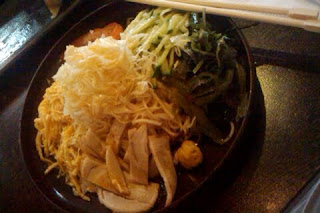I'm intrigued by Japanese Cuisine at the moment.
It seems to be absolutely delicious, yet some-what healthy!
Yes, I'm becoming health-crazy :)
It's like a glossary, explaining all those different condiments
Although some of these condiments seem unhealthy, they are eaten in SMALL amounts.
 Japanese Mayonnaise
Japanese MayonnaiseMade from regular mayonnaise, rice vinegar and small amounts of MSG
Found at supermarkets, asian grocers in soft plastic squeeze bottles
(As pictured above)
Can be used in salads, with chicken, Okonomiyaki, Takoyaki or sometimes even on pizza~!
 Mirin 味醂
Mirin 味醂Made of a Rice Wine (Alcohol Cont: 14%) and Sugar (50%)
There are three types of Mirin:
Hon Mirin (Contains Alc.)
Shio Mirin (Contains Alc +1.5% Salt, to avoid alc. tax)
Shin Mirin/Mirin-fu Chomiryo (Contains Under 1% alc. But has the same flavour)
Found at supermarkets, asian grocers in plastic/glass bottons
(As pictured above)
Usually used in Teriyaki sauce and to erase the unpleasant fishi-ness from boiled and grilled fish.
 Rice Vinegar 米酢
Rice Vinegar 米酢Made from fermented rice , sometimes with sake, salt and sugar.
Rice vinegar tastes much more milder and sweeter than normal vinegar and appears a pale yellow colour
It's found anywhere- supermarkets, asian grocers.
It's used in salad dressings, as well as in the process of sushi rice.
The rice vinegar gives sushi rice a balanced sweet-sour taste and it also makes the sushi rice shiny.
 Soy Sauce 醤油(shoyu)
Soy Sauce 醤油(shoyu)Made from fermented soybeans with water and salt.
There are many, many different varieties of Japanese soy sauce.
Compared to Chinese soy sauces, Japanese versions often use wheat, giving it a sweeter taste.
INTERESTING:
Soy sauce in Japan, is sold in different grades depending on amount of nitrogen.
Hyojun (標準): Standard grade (More than 1.2% Nitrogen)
Jokyu (上級): Upper grade, (More than 1.35% Nitrogen)
Tokkyu (特級): Special grade, (More than 1.5% Nitrogen)
It's used in most savoury dishes, usually as a seasoning - much like how we'd use salt.
 Wasabi 山葵
Wasabi 山葵 Genuine wasabi is made from the roots of the wasabi plant.
This root is usually grated on a 'Shark Skin Wasabi Grater'
It can be bought from most stores, usually in small tubes.
However, most products that claim to be 'wasabi' are in actual fact made of grated horseradish and green food colouring...
Apparently, true wasabi tastes quite different.
Wasabi is widely known for being eaten as a condiment with sushi or sashimi
 Karashi 芥子
Karashi 芥子
Karashi is a type of Japanese mustard.
It can be found in asian grocers, and comes in powder form or paste (usually in tubes)
Karashi is usually used as a seasoning, condiment or sauce, much like how Western Cuisine utilizes mustard.
 Nori 海苔
Nori 海苔Nori is the Japanese term for dried seaweed.
It is made from shredding and rack drying seaweed.
Did you know that the seaweed industry earns over $2 Billion US Dollars a year!?
Nori can be found at supermarkets and asian grocers.
This type of seaweed is used to wrap sushi or nigiri, or as a garnish for many rice, noodle, soup dishes.
 Katsuobushi 鰹節
Katsuobushi 鰹節Katsuobushi (also known as Bonito Flakes) is a dried, fermented and smoked skipjack tuna.
These blocks of fish are usually shaved into.. thin shavings by a traditional wooden ... shaver, known as Katsuobushi Kezuriki
These shavings are most likely found at asian grocers
Katsuobushi appears a wooden brown colour.
It is primarily used as a garnish and when placed on a hot dish, the steam makes the flakes seem to 'dance.'
 Rayu ラー油 (or La-yu)
Rayu ラー油 (or La-yu)Rayu is a Japanese chilli-infused vegetable oil.
The oil has a reddish tinge to it and usually contains various other ingredients to enhance the flavour of rayu.
I assume that this would be found at asian grocers and would be used as a seasoning or condiment on any dish.
 Furikake 振り掛け
Furikake 振り掛けFurikake is a condiment made out of dried,ground fish, sesame seeds, chopped seaweed, sugar and salt.
Again, I believe this can only be found at asian grocers.
The condiment is bright and colourful and is usually used as a seasoning/condiment on various dishes- depending on personal taste.
Well, that's my extensive list of Japanese condiments.
So if you ever go to Japanese restaurant and see a weird looking bottle or jar, you'll be able to think back to this. :)
Any more to add?
WB.














































